repompe du site http://members.aol.com/ThaiRing/street.html
By Pop PraditbatugaWelcome to my Street Fighting site. On this site, my friend and I will personally demonstrate various techniques that can be used to save your life in the streets. This site should serve as an overview of street fighting techniques available, and it is NOT intended to replace actual lessons. You cannot learn all of your techniques from pictures on the internet. Furthermore, I am in no way claiming that I am an expert. Let me say that again: I AM NOT AN EXPERT. If I stepped into the UFC or Lumpinee Stadium in Bangkok, I would literally die. I am not responsible for any injuries that you may incur as a result of trying to apply the techniques presented on any of my pages.
The fighters most often encountered on the streets are not your average professional fighters. There are the big and dangerous fighters out there, but most good fighters do not start fights. However, just because most street thugs are less skilled in fighting, it would be a dangerous mistake to assume that they are less dangerous than the professional fighter. In any given confrontation you must also evaluate the surrounding environment. The environment in the streets includes elements of uncertainties and surprises not ubiquitous in a professional match. I am often reminded of the sad story of a U.S. Marine soldier who survived the Persian Gulf War only to be gunned down by a teenager in the streets of Los Angeles. No matter how hard you've trained for combat, the street is always a dangerous place. I have a background in law enforcement and I can tell you that the number of crimes committed is staggering. Never assume that you are safe at all times. In a life and death situation, you have to at least try even if your techniques are not 100 percent effective. However, if talking your way out, backing down, or running will save you from physical confrontation, then please take these foregoing routes. There are no place for champions in the streets; street champions are quickly honored with their own tombstones. And if there are any street thugs viewing this website, please make a change of heart. Deep down inside if there is still a spot of goodness within your heart then please turn your life around. If you enjoy combat, there are many sport combat competitions, which are much better than endangering the lives of the innocents. Think about it and thank you.
The techniques presented here reflect my
personal preferences. I rely on Muay Thai for strikes and stand-up clinching
(especially military style, which was rubbed off on me by my father who served
in the Royal Thai Army); Brazilian Jiu-Jitsu and Sambo for groundfighting. Sambo
has the best leglocks and neck breaks that I've experienced - not for beginners
who don't know how to immediately release a hold when their partners tap.;
and the Filipino Kali Silat/Escrima for knife and stick fighting. I was first
introduced to Kali by Burton Richardson who used to teach a class at UCLA many
years ago when I was still an undergrad. I can tell you that an experienced
knife fighter is nearly as dangerous as a man with a gun! At any given time, I
may use a combination of different martial arts in a single sequence. I choose
to separately name all the styles that have contributed to my personal system in
order to give each respect rather than renaming the combination of these arts
with an exotic new and meaningless name. Well, I hope this site will give you
some valuable insights into the world of street fighting. We did not prepare for
this presentation. All techniques are applied as the attack is initiated. Some
techniques may be executed with less than perfection, and there are no pretty
falls into the same spot. As in the real situation, we are often caught
off-guard without even the thought of going into the appropriate stance. Some of
you street cops know exactly what I'm talking about.
HEADLOCK ESCAPE 1 |
|||
 |
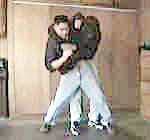 |
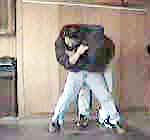 |
 |
|
Here the assailant has me in a stand-up headlock. Should I apply this technique? Yes, because he is not punching me, he is not standing in front of me in a way that would prevent me from stepping in front of him, and he is not throwing me down to the ground. If he is doing any of the aforementioned things, then you must apply another technique. There is always a "What if he does this?" question. The answer is to apply the next appropriate technique if he is doing something else. Don't get fixated on forcing one technique when it is not working. (1) I step in front of the assailant with my left leg. (2) At the same time, I reach over his right shoulder with my left arm and grab my right arm. (3 - 4) With my butt up against him, I initiate the takedown throw drawing power from my hip and shoulder. He will usually let go as he falls. If he doesn't there's another follow-up technique to be discussed later. In a headlock when only one side of your neck is being pressured by your opponent's arm, you will not go unconscious despite the uncomfortable feeling. Anatomically, both sides of your neck has to be pressured or the area around your Adam's apple has to be squeezed in order to render you unconscious. |
|||
HEADLOCK ESCAPE 2 |
||
 |
 |
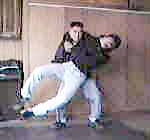 |
|
Here I cannot use the previous technique because the assailant's leg is blocking me and preventing me from stepping in front of him. Therefore, (1) I did my left hand and arm under his neck over my left shoulder. (2) I grab his face and eyes while pushing his face away from me with my hand. (3) I lift his leg up with my other hand and throw him down, either on top of my left knee first or directly onto the ground. There will be potential injuries to his eyes, back, and/or ribs. He should let go by the time he hits the ground. If not, proceed with the next technique. |
||
HEADLOCK ESCAPE 3 |
|||
 |
 |
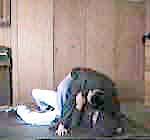 |
 |
 |
 |
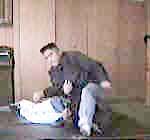 |
 |
|
(1) This is an extension of HEADLOCK ESCAPE 2 where the assailant is so strong and persistent that he hangs on to the headlock even after you throw him to the ground. (2) Once on the ground, I establish my position by planting both hands on the ground. (3) I bring my right leg over his body and wrap it close to his body to prevent him from moving. My other knee is behind his back. (4) I slide in my left hand, using the sharp edge of my hand to move through beneath his neck. (5) I plant both hands on the floor and (6) simply lean my head forward. With this leverage I cause him to let go without using much energy. (7) I grab one of his arms, extend it, and (8) bring my other leg over to apply the arm lock. In order for the armlock to work, his thumb should be pointed up towards me, my knees should be tight together, and I should raise my hip up. |
|||
HEADLOCK AND PUNCHING |
|||
 (Step 1) |
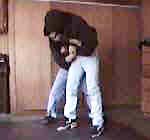 (Step 2) |
 (Step 3) |
 (Step 4) |
 (Step 5) |
 (Alternative Step 1) |
 (Alternative Step 2) |
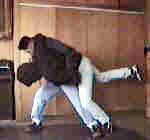 (Alternative Step 3) |
|
In Steps 1 - 5, I am in a headlock and being punched. (1) I stop the punches by blocking it with my right open palm. If possible, I will catch his fist. (2) I sneak my left arm underneath his left armpit and grab the wrist of the arm that he was punching me with. I have now stopped his punches. (3) I grab the wrist of his right arm (i.e., the arm around my neck). (4) I step backwards with my right leg, look up, and quickly bring my head back close to his body underneath his arm and pull my head out of the headlock. (5) I apply an armlock on him. Law enforcement officers can put the cuffs on from this position. Alternatively, in Alternative Steps 1 - 3, I also realize that the assailant gives me room to step in front of him. (1) I block his punch with my right open palm. (2) I dig under his armpit with my left arm, grab the wrist of his punching arm to stop the punches, grab the wrist of the arm around my neck with my right hand. (3) I step in front of him and initiate the throw similar to HEADLOCK ESCAPE 1. Because I have both of his arms, he cannot break his fall, and he will most likely suffer from severe injury. |
|||
HEADLOCK ESCAPE FROM THE GROUND |
|||
 (Step 1) |
 (Step 2) |
 (Step 3) |
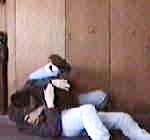 (Step 4) |
 (Step 5) |
 (Step 6) |
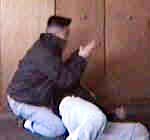 (Step 7) |
 (Step 8) |
|
Now this is a very common position to get into in a street fight. There are variations depending on the position of your opponent's head, etc. This is just one technique. (1) I lift one shoulder off the ground to avoid being helplessly flat on my back. (2) I bring my left arm around and hold it with my bottom right arm in order to form a resistance to prevent him from putting his head down. (3) I begin to move my body and legs while pushing his head away from my body. (4) I bring my leg over and place it over his head. Leg strength is naturally more powerful than the neck muscle. (Step 5) While pushing his head and neck with my leg, I also try to roll his body over. At this stage, the force of my leg muscle may force him to release the headlock. In that case, I will immediately proceed to the armlock. If he still hangs on then I will have to proceed with Step 6. (6) I roll his body over. With my other knee anchored firmly on the ground, I can apply tremendous force with my other leg to his head and neck. He will have to let go of the headlock. (7) I grab the loose arm. (8) I apply the armlock. |
|||
ESCAPING FROM THE GUILLOTINE |
||
 |
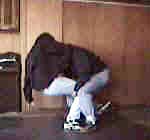 |
 |
|
Once the guillotine is on completely and correctly, it is almost impossible to escape before being choked out. People who usually lower their head in stand-up clinching or take-down maneuvers are particularly susceptible to this choke. One prevention is to tightly tuck your chin against your chest. You should also try to extend one arm outward in such a way that one side of your head will tightly rest against it. This will prevent him from applying pressure to both sides of your head. If it is too late and you are already in his hold, proceed with the example demonstrated above. (1) I lower my body to establish a firm lower position. He can only choke me now if he is able to straighten up his body. To keep him lower, I reach over his shoulder and grab his back with one arm while simultaneously pushing his leg with the other arm. He will no longer be able to extend his body. (2) I initially went for the single leg take-down while my other arm was still over and grabbing his back. Remember, this was unplanned and unrehearsed. You have to improvise. Because my partner (i.e., the assailant) released the choke sooner than I expected, I decided to slide my other arm down and go for the double-leg take-down. (3) I mounted the fallen assailant and delivered a series of elbows. In the mount, I wrapped my legs around his hip area to prevent his movement. If he does not tuck his elbow tightly to the side of his body, I can also choose to move up. Nevertheless, the elbow smashes should quickly end the fight. |
||
ESCAPE FROM BEAR HUG WITH ARMS STILL FREE |
|||
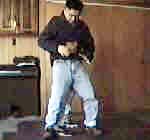 |
 |
 |
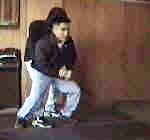 |
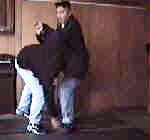
The assailant has a rear bear hug on me, but my arms are still free. (1) I quickly look to see which of his hand is on top of his hold. That is the hand that will be easiest to remove and break his hold. Since his left hand is on top of his right wrist, I grab his left wrist with my right hand. Stop and visualize this so you won't get confused. (2 - 3) I then dig under his left arm and grab my right wrist, with my right hand still holding on to his left wrist. (4) With this hold on, I merely lower my body as if sitting down to break his hold. This is using leverage, not strength! (5) As soon as he breaks his hold, his arm will still be in my hold. I then turn my body around and apply an armlock. Now if he had made the initial mistake of interlacing his fingers when he bear hugged me, I would have just grabbed his fingers and squeezed them. Don't get fixated on forcing one technique if other options may work better and faster. The good thing about grappling is that you usually have more time to think (although still not much) than when you are in the striking range. I will cover Muay Thai striking later. |
|||
ESCAPE FROM BEAR HUG WITH ARMS TRAPPED |
|||
 |
 |
 |
 |

(1) Here the assailant has me in a bear hug with both of my arms trapped. (2) I lower my stance to establish a firm position. (3 - 4) I lower my body and grab his nearest ankle. (5) I simply pull his ankle up to cause him to fall. Once he falls, you can sit on top of his hip and lift one of his leg straight up to apply a knee lock, or I can turn around and go for the mount position. I can even choose to run away and call for help. Also, keep in mind that every maneuver has a prevention or a counter-attack. Being in the rear, your opponent could also go for a rear choke. And if he's very strong, he may even lift you up and throw you on your head backwards (i.e., a suplex). In that case, as one visitor to this site suggested, you would have to quickly hook one foot around the outside of your opponent's knee as he's picking you up to prevent the suplex. If possible, you never want to have your back exposed to any attack. But in the streets, surprises do happen. |
|||
ESCAPE FROM REAR NECK CHOKE |
|||
 |
 |
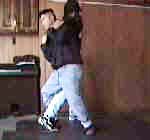 |
 |
|
(1) The assailant has me in a rear neck choke. Before he can apply a stronger choking technique, I want to quickly escape. I may do a rear head-butt to create some space, but it is usually not necessary. I grab his arm with both hands and put some weight on it to lessen the pressure. (2) I hook my leg to his leg, which is on the same side as the arm that he is using to choke me with. (3 - 4) I turn my body around and push him down. Notice that the leg I hooked him with is now used as an anchor to trip him. Once he falls I can proceed with the mount or stomp him. |
|||
ATTACKING FROM THE GUARD |
|||
 (1) |
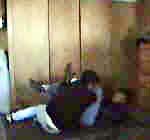 (2) |
 (3) |
 (4) - Alternative Finish |
|
This is the position that the Brazilian Jiu-Jitsu stylists have brought to the world of self defense. When it comes to fighting with the back on the ground, they are the best at it. I try to prepare myself for all ranges of fighting, and this is one very important range. When fighting one-on-one in the streets, being on your back is a high possibility. There are numerous attacks from the guard position; I will demonstrate just two. When you are taken down by your opponent, make sure that you open your legs so that he will end up in between your legs. When this happens, the opponent is in your "guard". In order to strike from the guard position, you should slightly raise one or both sides of your body. (1) The opponent is on top of me and extends his arm towards my throat to attempt a choke. I pull his extended right arm towards my right. (2) I lift my left leg up over his head and push his head down, while pulling on his right arm. (3) I attempt to apply the arm lock. If I make a mistake here, I can still strike his face fairly hard with my heel. (4) Alternatively, the opponent tries to pound my face while he is on top. I grab both of his arms and pull him closer. His head is resting on my chest area. I can strike his head with elbows. However, I decided to quickly bring my left palm up and push his face to my right side. With my right hand I dig under his throat, lock it with the sharp edge of my forearm and lay flat down to apply the guillotine choke. The guard and the methods of escaping the guard are important techniques to know, especially when fighting a more experienced fighter. This is just two attacks from the guard; there are numerous attacks and counter-attacks. Fortunately, most street thugs still do not know much about defending against or applying this position. If the opponent is large and you have him laying in your guard for a long time, go ahead and constantly kick the side of his body (i.e., around his kidneys) with your heels. Biologically, constant strikes to the kidneys will cause him to urinate blood even days after the fight. |
|||
My partner
(i.e., the assailant) and I will cover many of the striking components that can
be used in the streets. Being born in a country where Muay Thai is the National
Sport (i.e. Bangkok, Thailand), I naturally love to strike. Although nowadays I
am getting too old to compete in it as a sport. Muay Thai is a striking system
with stand-up grappling that really works. Even among successful grapplers who
do not like striking arts, Muay Thai is often cited as the one striking art that
they find useful and powerful. The Royal Thai Police still uses it in street
applications. For my personal empty-hand combat system, I use both Muay Thai and
Brazilian Jiu-Jitsu. I may also include a few techniques from the other arts.
You may have your own personal preferences, but these are the systems reflected
on this page.
STOPPING A STOMPING ATTACK |
||||
 (1) |
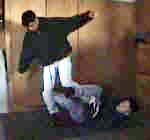 (2) |
 (Result 1) |
 (Result 2) |
|
(1) I fell to the floor and my opponent is ready to stomp on me. In training, the opponent may always step in the same place; however, this is not what happens in the streets. Until he stomps, I don't even know how hard he will stomp. He can also stomp so fast that I cannot capture his foot in the right place to apply an effective footlock. This is why I will discuss the various results. The first thing I have to do is capture his foot with my open palm. One hand in the bottom of the foot and one hand on the rear part of his ankle area. Notice that I am also hooking his right leg with my left foot. (2) I bring my right leg over his left leg and use my leg muscles to bring him down. (Result 1) When he falls in this position, I will twist his foot and apply a footlock if possible. If not, I will kick him in the butt and get up quickly to mount on his back and apply the rear choke, etc. (Result 2) This is the result one would train for. I was fortunate that he stomp in an area where I was able to capture his foot and tuck it underneath my arm. Using the techniques described in step (2) I bring him down flat on his back. I can now apply the ankle lock. (Result 3) Because I was too far out the ankle lock didn't work. I then kicked the opponent in the groin. All men will be temporarily immobilized when their groin area is kicked hard. I know that most instructors will tell you that you should learn the ankle lock so well that you can apply them correctly everytime. But what if you make a mistake in the streets? This is why I give alternatives even when mistakes are made. I believe that it is very important to do so. |
||||
Khun Yak Pa Nang (Giant Steals the Girl) - A Muay Thai Complimentary Trick |
||
 |
 |
 |
|
No, this is not a lovely embrace between my male opponent and I. So don't even think about it - haha! But seriously, this is literally a deadly embrace. It is so deadly that it is banned in the Muay Thai rings. It is a trick known as Khun Yak Pa Nang (Giant Steals the Girl). On Page 2, I demonstrated techniques against bear hugs from the rear. What about frontal bear hugs? The clinching techniques of Muay Thai are the perfect arsenal. In essence, it is like a controlled bear hug with deadly striking potentials. It is what separates fighting in the rings of Thailand to fighting anywhere else. (1) In this movement, I grabbed my opponent by the waist. (2) I lift his hip up while placing my chin tightly against his chest. If you're doing this right, the pressure from your chin should be painful to him. (3) As I lift him off balance, I will simultaneously push him downwards with my chin. The idea is to have his head crash into the floor. If the floor is hard enough, serious head injury or death would be highly probable. This technique remains alive in military-style Muay Thai, but it is not allowed in sport Muay Thai. |
||
From Burmese Boar Bando - Deadly Head Smashing Technique |
||
 |
 |
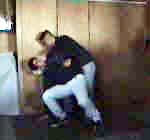 |
|
Burma's Fighting Techniques are well-known to the ancient warriors of Thailand. In fact, the two countries battled each other regularly in the ancient days. Thus, the fighting styles from Thailand and Burma are battle tested. They kept only what worked in actual fights. (1 - 2) The assailant was ready to punch me. I stepped to the side placing my left leg behind his right leg. With my left hand I struck his chin hard with the palm of my hand and continued to push his chin in the direction of the fall. Simultaneously, I grab his hair and pull hard towards the ground. (3) The combination of pushing his chin with my palm, pulling his hair downwards, and tripping him with my leg will make the fall inevitable. The idea is to bring his head crashing down to the hard floor. In modern streets, this means concrete! This method of head control can be modified and used in a tight clinch or from the mount position. Even if your opponent holds you tight, it is not difficult to sneak your palm underneath his chin. |
||
MUAY THAI FOR THE STREETS |
|||
 (1) |
 (2) |
 (3) |
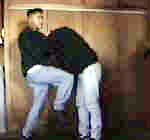 (4) |
 (5) |
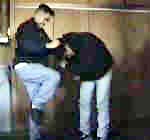 (6) |
 (7) |
 (8) |
 (9) |
 (10) |
 (11) |
 (12) |
 (13) |
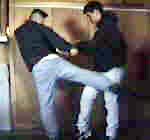 (14) |
 (15) |
 (16) |
|
(Steps 1 - 4) The opponent tries to pull my head down for the knee. I slip both of my arms inside his grabbing arms and grab the back of his head. The one with the grab inside is the one with more leverage. With my elbows up against his chest and my hand behind his head, I can easily pivot his head down towards my knee strike. You can also grab him behind the neck. Locking your fingers behind his neck and jerking his head around may give you a better hold, but he has less muscular resistance if you put the force on his head rather than his neck. In the ring against a more experienced Muay Thai stylist, you will have to clinch very tight. Your chin should also stick very tight to his body or you will catch an elbow. The Muay Thai clinch can be very difficult to master. Each year experienced kickboxers from all over the world would enter Bangkok to test their skills; this is the range that they often lose to the Thais regardless of how prepared they think they are. For street applications against average thugs, I do not believe that you will have to know it that well. You may even end up on the ground first. But if you get a knee in, it can end the fight very fast. The clinch with elbows and knees is also the perfect system to apply when the opponent has you in a frontal bear hug. (Steps 5 -6) I pull my opponent by the hair to facilitate the bringing down of his head for the knee strike. This technique is common in military style. Obviously, it is not seen in sport Muay Thai because the boxers wear gloves. If your opponent is bald or has very short hair, you may grab his ears. (Steps 7 - 8) My opponent has me in a tight clinch and I cannot force my arms inside his hold for an advantage in leverage. I simply push one of his arms up by pushing his elbow. I quickly follow with a round knee strike to his ribs. (Steps 9 - 10) Once my opponent's head is suppressed, I deliver alternating knee strikes. Learn how to switch your legs to deliver multiple knee strikes without losing your balance. (10) I can also strike the back of his head or spinal cord with an elbow. (Step 11) I deliver a right cross to his chin. I just want to remind you people that you should not underestimate the punch, especially if you or your opponent is a heavy puncher. Unlike other forms of kickboxing where most knockouts are produced by punches because of ineffective kicking techniques, Muay Thai has effective kicks, elbows, and knees that constantly produce knockouts in competition. Consequently, many Muay Thai stylists may overlook their boxing techniques. Don't! Unless you have no power in your punches, do not forget the boxing component. However, remember that against a Muay Thai stylist in the streets or in the ring, do not "bob and weave". You lower your head and you will catch a devastating knee. If you don't think a knee produces power, get a thick phone book and punch it as hard as you can, then hold it with both hands and knee it as hard as you can. You will see how much more powerful the knee can be. In short, use all your arsenals wisely and don't get fixated. Yet, keep it simple enough so that you can react instinctively in the moment of surprise. (Step 12) I deliver an uppercut elbow as my opponent steps in too close. Muay Thai has many elbow techniques which can be delivered from all angles. Other martial arts have elbows, but Muay Thai by far has the most comprehensive set of battle-tested elbow techniques. For fighters stepping into Lumpinee Stadium, the elbow is the object of fear because the fighters in Thailand deliver them so well. In the streets, it is a quick way to draw blood from your opponent. However, with the global AIDS epidemic, you should be very careful after making your opponent bleed. If the delayed death touch is true, it could happen here if your bloody opponent is HIV positive and you also have an opened wound. Touching his blood alone will not give you the AIDS virus; but if you have an opened wound, then take extra precautions. Perhaps if you are also bleeding from his attack, you can also scare your opponent away by lying to him about how you are HIV positive. It should make most people leave you alone if you are bleeding. Street Fighting is about survival not honesty and honor. (Steps 13 - 15) I deliver the Muay Thai Roundhouse Kick to my opponent's body. The kick can be delivered to the head area, the mid-section, and the legs. In terms of physics, the Muay Thai kick is harder than any other kicks in the world of martial arts. You can argue against this claim all you want, but with my strong background in physics, mathematics, and the martial arts, I am telling you the truth! It is not by ignorance that the Thai fighters use this kick almost exclusively in the ring. This kick have sent people out on stretchers, killed people, and broken bones. It strikes the opponent hard with the shin bone. If you learn how to block it with your shins, you can survive. If you can't stop it, then it can inflict serious injuries on you. In the streets, most thugs do not know how to block this kick. From experience, I can tell you that it penetrates most of their guard. I've delivered this kick to Tae Kwon Do and Karate black belts in my younger days and their body twisted with the impact. I draw the power from my hips. Here, I deliver it lightly because my opponent is my partner; therefore, my right arm did not come down lower to counter the force of the kick. If this kick is thrown full force, the arm on the side of the kicking leg should drop in the opposite direction to maintain your balance. The supporting foot should also turn. I don't think you should learn this kick for the first time with pictures or even videos. Get instructions and do it right. It will be worth it because it is the kick that you will throw most often. Have patience when conditioning the shins. Work on heavy bags, Thai pads, and eventually your partner's shins. DO NOT KICK WOOD! Anyone who tells you to strike your shins against wood is a bad instructor who knows very little about the human body. That is a quick way to get permanent injury. Thai boxers of the past used to kick banana trees. Banana trees are rubbery in texture, not wooden. So don't let myths overcome your common sense. (Step 16) In French Savate, the point of the shoe is used for inflicting great pain. You don't need a silver glove rank in Savate to deliver this kick. I just kicked my opponent in his groin with the point of my shoe. It doesn't matter whether you want to use the instep or the tip of your shoe. You kick a man hard in the groin in the streets when he is not wearing a steel cup, and he ain't getting up for a while! This is the old-fashion way to end a street fight and it still works. Don't overlook it with all the other more complex techniques. Click here for more pages of battle-tested Muay Thai techniques directly from Thailand. |
|||
I will discuss techniques for knife protection and gun retention. The gun retention techniques discussed briefly here are taken from methods used by the Royal Thai Police. It is intended for law enforcement officers. I doubt if the average citizen will walk around with a gun and a holster. I may demonstrate techniques against an assailant with a gun later. For this page, I will assume that the officer being attacked is the one with the gun.
One thing that you should keep is your common
sense. There is no martial arts technique that can protect you from weapons most
of the time. Matter-of-fact, the odds are against you if your opponent has a
weapon. Even after learning these techniques, you cannot go out and say that you
are an expert. You are at most familiar with the things you should do. Your
common sense should tell you that you should first give in to the demands of
your armed assailant if doing so would save your life. You can buy another
diamond ring, but another life you will not have. Use these techniques only if
it is certain that if you do not try something you will be killed. With that in
mind, your primary weapon is communication and psychology and the following
techniques should be your last resort.
PROTECTION AGAINST KNIFE ATTACKS |
|||
 (1) |
 (2) |
 (3) |
 (4) |
 (5) |
 (1a) |
 (2a) |
 (3a) |
|
Muay Thai brought the Southeast Asian Martial Arts to the forefront of empty-hand combat. What many people still do not know is that the Southeast Asian Martial Arts such as Krabi Krabong from Thailand and Kali Silat from the Phillipines also excel at defenses against knives, sticks, and clubs. From my observation, Kali Silat is the best weapon system available. In the ancient days, fighters had to deal with knife and sword fighters. The following technique is used by the Royal Thai Police (1) The assailant tries to stab me. From the way that he's holding his knife, I know that he will bring the knife downwards. (2) I must move out of the predicted knife's path by stepping outside. I block and grab his arm with my right hand. I want to stay fairly close to him to be able to block him effectively and to prevent him from doing a follow-up. (3) While extending his arm with my right hand I raise my left arm up in a striking motion and strike his arm as hard as I can with the sharp edge of my forearm. The impact may make him let go of the knife. (4) If he still has the knife, I will bring his arm up on my shoulder and (5) apply an armlock. (Alternative Steps 1a - 3a) The assailant is holding the knife in a way that lets me know that he will most likely slash upwards. The reason why the Southeast Asian techniques are preferred is because they preserve simplicity. In the heat of a dangerous attack, few people have the time to think about what next move to apply based on the way he's holding the knife. Here, I will respect the path of the knife, move out of the way, and apply the exact same technique as in the previous attack. I've seen other martial arts apply fancy effective holds during practice that reveal their lack of understanding for knife fighting. Many skills may work against a non-skilled knife fighter, but with one chance should you take the risk and assume that your opponent is not skilled? The common mistake I see with other holds is that although they are very effective against the knife wielding arm, they give the experienced knife fighter room to simply pass the knife to his other hand and easily kill you with it. You must understand knife fighting to defend against knife fighting. |
|||
PROTECTION AGAINST THE BASEBALL BAT |
||||
 (1) |
 (2) |
 (3) |
 (4) |
|
The bat is a very powerful weapon. If it's going to hit you, protect your head first. If it hits your arms or legs, it may break it, but at least you will not die and may still be able to run away. Do not turn your back into a bat because if it injures your spinal cord, you can become paralyzed. The ideal thing to do is to get out of its path. The path of the bat is usually not going to include the back of the assailant's body. (1) The assailant attacks me with a bat. By the way he's holding it, I know that the path of the bat will be swung inward across his body. (2) I try to move out of the path of the bat. I also keep my palms and forearms up so that if I do not make it in time I can readily protect my head. (3) I move to his back where it will be unlikely for him to follow up with his missed swing. (4) I take him down by wrapping my leg around him. I also pull his hair to move his head into my choke hold. (5) I apply the choke hold. |
||||
GUN RETENTION TECHNIQUE #1 FOR LAW ENFORCEMENT OFFICERS |
|||
 (1) |
 (2) |
 (3) |
 (4) |
|
I can't emphasize the importance of simplicity enough for a dangerous surprised situation such as this. When an attacker grabs your weapon, there is a feeling of fear that runs up your body that will momentarily block your mind from being able to think of applying any techique that involves multiple maneuvers. There are lots of effective joint locks out there, but in order to apply them in seconds, you will have to take into consideration which hand and arm is your opponent attacking with, etc. Some police officers may be good at this, but most are not. This is why these Military Muay Thai techniques used by the Thai police forces and military are gaining popularity. I hope to see it introduced in Ft. Quantico, Glynco, and other local, state, and federal law enforcement training centers across the United States, if it has not yet been introduced. (1) The attacker reaches for my gun. I grab for his hand to secure it firmly so that he will not be able to withdraw it. The side holster is really the best because it makes it most difficult for him to withdraw and easiest for you to hold his hand firmly. Those shoulder holsters popular with Special Agents and Detectives where the handle of the gun is pointed towards the attacker to be used at his disposal is dangerous, even though they may look "cool". (Steps 2 - 4) With the gun held firmly, I grab his neck or hair and pull him down towards the knee strikes. I strike his groin, stomach, and/or head repeatedly. I can then peel his grip off, push him away, and draw my gun. Departmental regulations may prevent groin strikes, etc. but come on, the guy has a hold of your gun and possibly your life. |
|||
GUN RETENTION TECHNIQUE #2 FOR LAW ENFORCEMENT OFFICERS |
||
 |
 |
 |
|
The assailant grabs my gun from the rear. I grab his hand and retain the gun. With my other arm I deliver the spinning back elbow (sok klab). I draw my gun and give him instructions to surrender. |
||
GUN RETENTION TECHNIQUE #3 FOR LAW ENFORCEMENT OFFICERS |
||
 |
 |
 |
|
The assailant grabs my gun and my
throat. I tuck my chin tightly to my body to prevent the choke. I grab
his hand and retain the gun. I switched hands and keep the gun retained
in order to deliver the spinning back elbow with my other arm to the
more vulnerable side of his head. Notice how I keep the techniques
simple. This is the end of my street fighting series for now. I hope it has given you insight to the various techniques available. For experts visiting my site, help educate the citizens. There is nothing more satisfying than knowing that the techniques you've taught have actually saved a life. Don't forget to sign my guestbook and visit my other sites. Sawadee Krub. |
||


